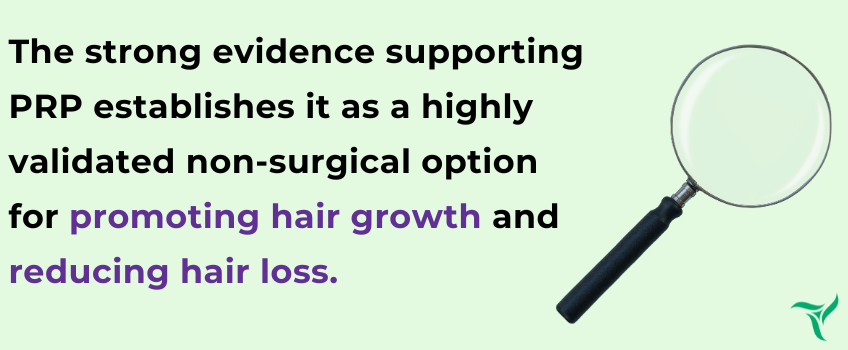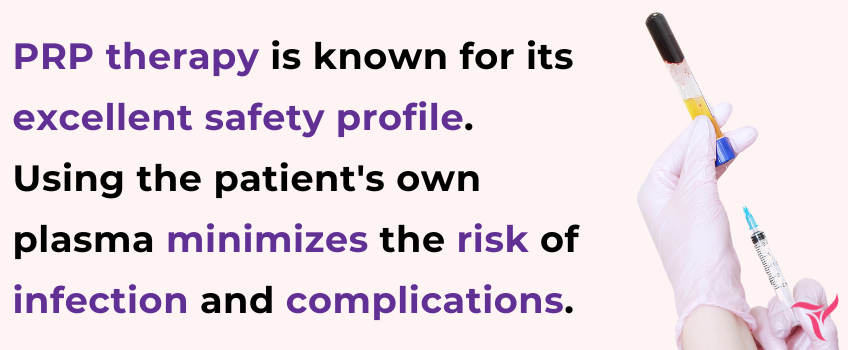
💳 Flexible Affirm Financing – Pay monthly with ease! How it works →

💳 Flexible Affirm Financing – Pay monthly with ease! How it works →
When dealing with hair loss, exploring effective treatment options is crucial. Both Mesotherapy and Platelet-Rich Plasma (PRP) therapy have shown promise as non-surgical methods to stimulate hair growth, each with its own unique approach. Here, we delve into these two treatments and how to figure out which one is best for you.
Mesotherapy, a minimally invasive procedure used for over fifty years in cosmetics for fat reduction, facial rejuvenation, and hair regrowth, shows promising results for pattern hair loss (Tang et al., 2022).
One of the key benefits of mesotherapy is the direct administration of the therapeutic agent into the skin. This method bypasses the challenges encountered by topical treatments, such as absorption barriers, allowing for a more targeted and effective approach to treatment (Ramos et al., 2023).
Mesotherapy treats hair loss by injecting a blend of nourishing substances directly into the scalp. The primary aim is to provide the hair follicles with essential nutrients to enhance growth and vitality. This method is appreciated for its direct delivery system, which ensures that the active substances are highly concentrated at the intended area, potentially increasing their efficacy.
Mesoline Hair is a specific product designed for Mesotherapy that enhances hair follicle health and promotes hair growth. It contains a targeted blend of active ingredients that are formulated to address common issues associated with hair thinning and loss.
Key ingredients in Mesoline hair:
1. Copper Peptides: Copper peptides are small fragments of proteins enriched with copper. They are known for their ability to encourage tissue remodeling and promote healing. In the context of hair health, copper peptides can boost follicle health by improving blood circulation to the scalp, enhancing the supply of nutrients to hair follicles, and potentially reducing scalp inflammation. This contributes to a healthier environment for hair growth and may also slow down hair loss.
2. Vitamins: The blend of essential vitamins in Mesoline Hair includes, but is not limited to, Biotin (Vitamin B7), Niacin (Vitamin B3), and Vitamin E. These vitamins are crucial for maintaining cellular health and protecting against oxidative stress:
3. Amino Acids: Amino acids, such as arginine, cysteine, and methionine, are fundamental components of hair’s keratin structure and play a critical role in hair health:
4. Hyaluronic Acid: Hyaluronic acid is renowned for its capacity to retain moisture. When included in Mesoline Hair, it helps to hydrate the scalp, maintaining proper moisture balance. This is crucial for keeping the hair follicles well-nourished and creating an optimal environment for hair growth. The hydration provided by hyaluronic acid can also reduce scalp dryness and flakiness, contributing to overall scalp health.
Enhanced Follicle Nourishment: By providing a rich mixture of growth factors and nutrients, it helps in strengthening hair roots and promotes hair density.
Tailored Treatment: The solution is designed to address both the aesthetic and physiological aspects of hair loss, making it a versatile option for various hair loss patterns.
Increased Treatment Efficacy: The targeted approach of Mesoline Hair in Mesotherapy may enhance the overall effectiveness of the treatments, offering better and potentially faster results.
A typical Mesoline Hair treatment involves multiple sessions, often recommended as a course of 3, 6 or more sessions, spaced about 1 week apart.
This regular interval helps maintain the stimulation of the hair follicles, leading to more consistent and visible improvements in hair growth and thickness.
Mesoline Hair is suitable for individuals experiencing early signs of hair thinning and those who have noticeable but not severe hair loss. It’s important for patients to have realistic expectations and to understand that results can vary based on individual factors such as age, health, and underlying causes of hair loss.
PRP therapy utilizes your own blood, processed to enrich the platelets, which are then re-injected into the scalp. These platelets release growth factors that help rejuvenate and regenerate hair follicles.
Well-Researched: PRP therapy is supported by numerous clinical studies that demonstrate its effectiveness in treating hair loss (Butt et al., 2019; Cervelli et al., 2014; Evans et al., 2022; Gentile & Garcovich, 2022; Mercuri et al., 2021). This robust evidence makes PRP one of the more scientifically validated non-surgical treatments available for stimulating hair growth and reducing hair loss.

Non-Invasive: PRP therapy is a non-surgical treatment that involves only injections into the scalp. This non-invasive approach avoids the need for any cuts or incisions, making the procedure relatively simple and comfortable.
Zero Downtime: One of the appealing aspects of PRP therapy is that it requires no downtime. Patients can usually return to their daily activities immediately after the session. This makes PRP a convenient option for those with busy schedules who cannot afford lengthy recovery times.

Very Safe: The safety profile of PRP therapy is exceptionally high. The procedure involves using the patient’s own plasma, reducing the risk of infection and complications associated with foreign substances. Side effects are typically minimal and might include temporary soreness or mild bruising at the injection site.
Versatile and Effective: PRP is not only useful for treating various stages of hair loss but also effective in enhancing the health and appearance of the hair. It works by stimulating the hair follicles to enter and prolong the growth phase of the hair cycle, which results in thicker, fuller hair.
LMC’s price match promise in Ontario guarantees you the best deal possible. If you find a lower price on an identical item, either locally or online, LMC won’t just match it—they’ll beat it by 10%.
Plus, with 0% financing available through PayBright, you can make your purchase now and pay over time, often without impacting your credit score, making big purchases easier to manage.

When it comes to mesotherapy vs PRP, PRP tends to show higher effectiveness in clinical studies. However, there is a minority who do respond better to mesotherapy hair treatments.
A regimen that combines both Mesotherapy and PRP could leverage the benefits of each, potentially enhancing overall effectiveness. Here’s how:
Targeted Nourishment and Growth Stimulation: Mesotherapy provides the necessary nutrients and PRP contributes growth factors, working together to enhance follicle health and function.
Increased Frequency of Treatments: Since Mesotherapy often requires more sessions to see visible results, interspersing these with PRP treatments could maintain stimulation of the hair follicles, leading to more consistent hair growth over time.
Both treatments are relatively safe, with common side effects including minor pain, bruising, and infection risk at the injection site. Combining treatments doesn’t significantly increase these risks but does require careful monitoring.
The combined approach of PRP (Platelet-Rich Plasma) therapy and mesotherapy is a compelling option for treating hair loss, catering to a broader spectrum of individuals facing this issue. Here’s a deeper look at who might benefit from this integrative treatment:
Individuals Who Haven’t Seen Sufficient Results from One Treatment Alone
For some people, a single method of treatment may not yield the desired outcomes. They might have tried PRP or mesotherapy independently and found the results lacking.
Combining PRP and Mesotherapy can enhance the effectiveness by synergizing their benefits. PRP involves using a concentration of a person’s own platelets to stimulate hair growth, which can be potentiated by the nutrient-rich injections of mesotherapy. This dual approach can potentially address the shortcomings of using either treatment in isolation.
Those with More Extensive or Varied Types of Hair Loss
Hair loss can manifest in various forms, from diffuse thinning to more pronounced bald patches, and can be due to numerous causes including genetics, hormonal imbalances, or environmental factors.
The comprehensive nature of combining PRP and mesotherapy makes it a versatile treatment option.
Mesotherapy provides the scalp with a boost of vitamins, minerals, and other growth factors, while PRP works to activate the natural healing process and regrowth at the cellular level. This can be particularly effective for those who suffer from different types of hair loss, as it tackles the problem from multiple angles.
Are you struggling with hair loss and haven’t found a treatment that works for you yet? Discover the power of combining PRP (Platelet-Rich Plasma) therapy and mesotherapy by scheduling a FREE consultation with LMC. As the leading provider of pure plasma (GFC) treatments in Canada, LMC has specialized in PRP therapies for over a decade, helping thousands of satisfied clients regain their confidence and hair.
Don’t settle for one-size-fits-all solutions. At LMC, we understand that hair loss varies from person to person, which is why we offer customized treatment plans that combine the regenerative capabilities of PRP with the nutrient-rich benefits of mesotherapy.
This dual approach targets your hair loss from multiple angles, increasing the effectiveness and catering to those with more extensive or varied types of hair loss.
Take the first step towards reclaiming your hair and confidence. Contact LMC today to book your complimentary hair consultation. Let our expert team, backed by years of experience and a track record of success, guide you towards a fuller, healthier head of hair.
Remember, when it comes to combating hair loss, LMC is your trusted partner. Don’t wait—reach out now and see why we are the #1 choice for PRP and mesotherapy treatments in Canada!